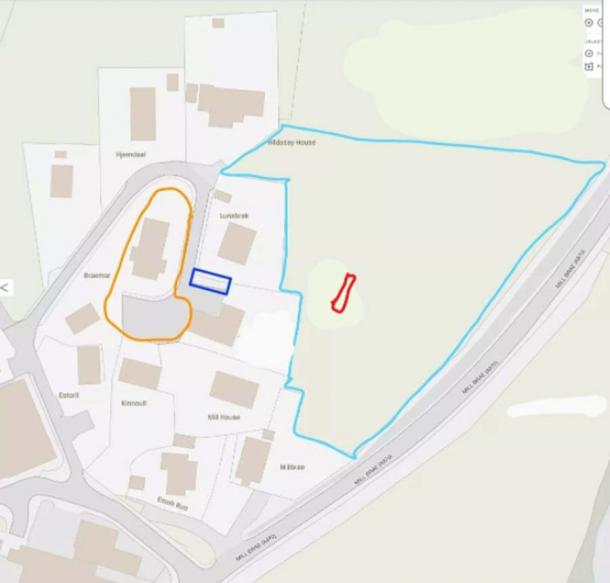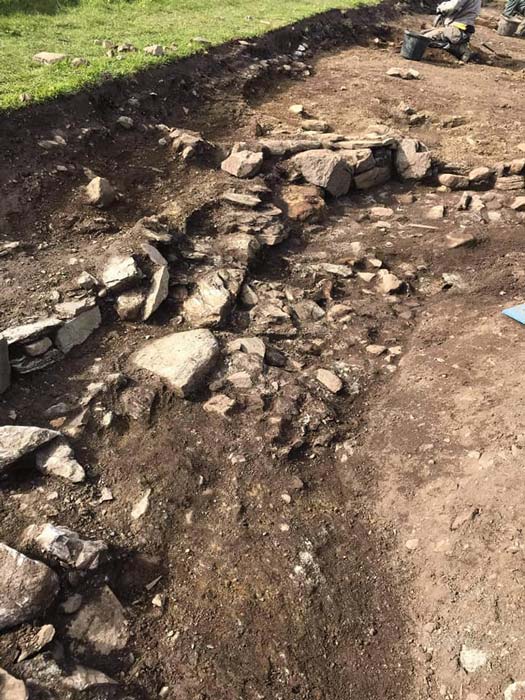What is being described by one Shetland islander as a “hugely significant discovery “ has reached the press. While nobody is just yet sure what the five ancient circular structures found on the Shetland Islands represent, on the final day of excavations the consensus is that Shetland ’s ancient Viking capital might have finally been discovered.
Back in March a Shetland News article announced a Crowdfunding campaign with a goal of raising funds for a two-week archaeological excavation in a field in Scalloway, Shetland. The planned dig site was beside Kristian Leith ’s garden, where last year , while laying foundations for a new shed, he discovered five round Pictish-period structures containing 26 human remains, and ancient artifacts including a comb and painted pebbles.
These discoveries were added to the expanding list of artifacts discovered at this site, which was first excavated in 1990 when a new house was being built on the edge of the field. The Crowdfunding campaign successfully reached its target of 26,762 dollars (22,601 Euros). And in May archaeological company ORCA conduced geophysical surveys in the adjacent land between the Mill Brae Road and Mr Leith’s home. A recent Shetland News piece has announced that archaeologists are “getting closer to revealing the ancient Viking capital of Shetland.”

Several excavations have been conducted in the area around the Scalloway, Shetland field. Orange = 1990 Sharples investigations. Dark blue = AOC 2020 investigations. Red= ORCA 2021 investigations trench 10 ( Skailway)
The Long Search For Shetland’s Lost Viking Capital
The Skailway project has reported findings of “huge significance” since Kristian Leith began hunting for the ancient Viking capital after finding the foundations of “five ancient structures and 26 human remains” in his garden.
The first nine archaeological test trenches revealed no new archaeology, but as fate would have it, on the last day of the investigation the foundations of another, even bigger, structure was identified. This possible drinking hall is thought to be part, if not the pulsing center, of the ancient Viking capital, Skailvoighand.

The possible drinking hall structure found in Trench 10 on the last day of recent excavations suggested that the lost Viking capital of Skailvoighand in the Shetland Islands has finally been found. ( Skailway)
ORCA’s official archaeological report is yet to be published but an excited Mr Leith said the discovery was of “huge significance.” He explained to Shetland Times how the ancient site had not been disturbed by later medieval burials or modern housing, and that this made the dig site unique.
He estimates that the site extends a minimum of “4,000 square meters (43,000 square feet),” which he says is “much larger” than archaeologists had previously estimated. Furthermore, the lucky gardener noted the discovery of “two red sandstone whetstones,” which he said were similar to discoveries found during a dig in 1990 dating back to 750-1000 AD, which encompassed the Viking period .

This red sandstone whetstone was found at the Shetland site and provided another piece of evidence of Vikings in the area and possibly also their long-lost capital. ( Skailway)
Treasure Hunting In A Windswept Viking Graveyard
Shetland was named by the first Norse colonists in the 9th century, who established their laws and language in the islands. From their native northern stronghold powerful Norse Vikings raided Scotland and Norway. And this prompted Harald Hårfagre to invade the Shetland Islands around 875 AD.
Hårfagre made Ragnvald, Earl of Møre and Earl of Orkney and Shetland in “compensation” for his lost son, who was killed defending Scotland. When Ragnvald died the earldom passed to his brother Sigurd the Mighty and this line of pagan Viking warlords ruled in Shetland until the island was Christianized in the 10th century and power shifted greatly to Rome.
This latest discovery is being deemed as so significant because Shetland is virtually treeless. While there are over 5,000 “buried” ancient sites, dating to between 4-2000 BC, Viking age archaeology, which lies much closer to the wind blasted surface, is relatively rare. The associated “games of thrones” that came along with centuries of Norse Vikings battling for power over Shetland were centered on the ancient capital at Scalloway, and the island’s capital only became Lerwick in 1708.
Mr Leith is convinced that the last test trench of the recent excavation, which revealed the edge of a large structure, is a clear clue that this is the lost ancient Viking capital Skailvoighand. He is so sure of this that he said, “Slowly but surely the story here is unveiling itself and we are getting closer to proving this is indeed the Skailvoigh settlement – the Viking capital of Shetland.”
Top image: Drone image of the excavation site that could be the location of the long-lost Viking capital of Skailvoighand in the Shetland Islands off Scotland. Source: Skailway
By Ashley Cowie
 RSS Feed
RSS Feed













 July 9th, 2021
July 9th, 2021  Awake Goy
Awake Goy  Posted in
Posted in  Tags:
Tags: 
















